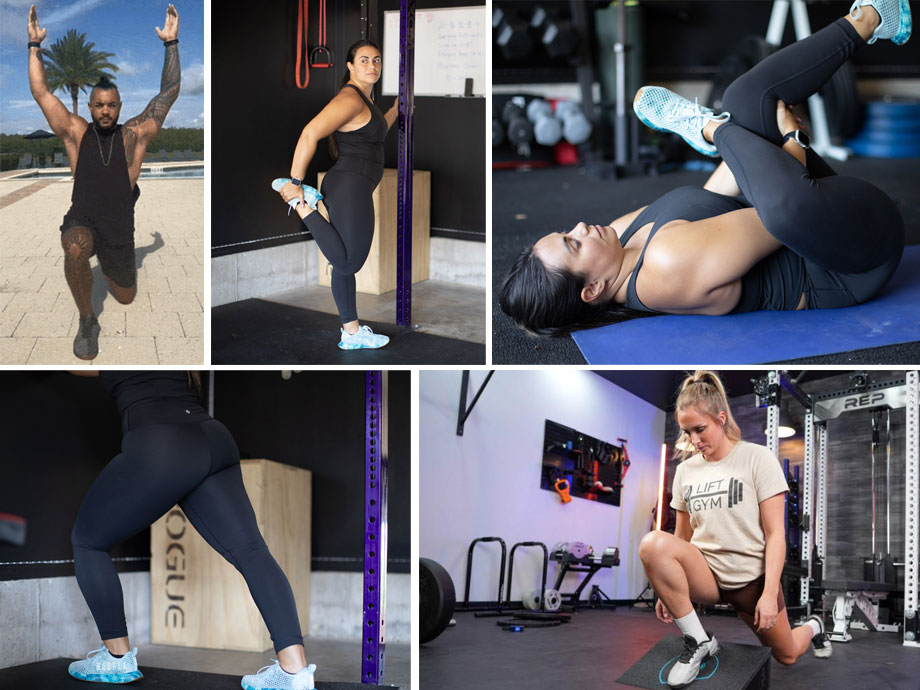We test and review fitness products based on an independent, multi-point methodology. If you use our links to purchase something, we may earn a commission. Read our disclosures.
According to a 2023 review in the Journal of the American Medical Association1, about 5% of all primary care visits in adults are about knee pain, reporting symptoms such as muscle soreness, stiffness, and chronic pain that may be associated with knee osteoarthritis—a painful condition that affects an estimated 654 million worldwide.
Knee pain is frustrating. Your knees help you show up and slay at the gym, but you also rely on them to do everyday activities like walking, running, and standing. If you want to continue doing the things you love, you’ll want to nip knee pain in the bud before it gets out of hand or rears its ugly head in the first place.
RELATED: Best Stretches for Leg Day
Studies show1 that stretching and strengthening exercises may help reduce knee pain and symptoms of osteoarthritis. So, we’re turning to Kate Meier, NASM-CPT, USAW-L1, CF-L1, for her expert opinion on the best knee stretches and knee exercises.
14 Best Knee Stretches
- Knee-to-chest stretch
- Hamstring stretch
- Straight-leg raise
- Quad stretch
- Side-lying adduction
- Seated leg raise
- Figure-four stretch
- Piriformis stretch
- Ankle mobility stretch
- Gastrocnemius calf stretch
- Half-kneeling hip flexor
- Wall squat
- Air squat
- Deep lunge stretch
Knee-to-Chest Stretch
Muscles worked: Hamstrings, glutes, hip flexors, lower back
Benefits: The knee-to-chest promotes knee health by targeting and stretching your hamstring muscles, one of the most integral muscle groups to proper knee function. It’s also classified as a “Williams back exercise,” which, according to StatPearls2, may help relieve lower back pain by hitting your lower back, glutes, and hip flexors.
How to do it:
- Lie flat on your back with your legs extended.
- Lift one leg, bend your knee, and bring it toward your chest.
- Grab your shin with both hands and gently pull your knee into your chest.
- Hold for 15 to 30 seconds, then release and return to the starting position.
- Repeat the stretch for your other leg.
RELATED: Best Hip Flexor Stretches
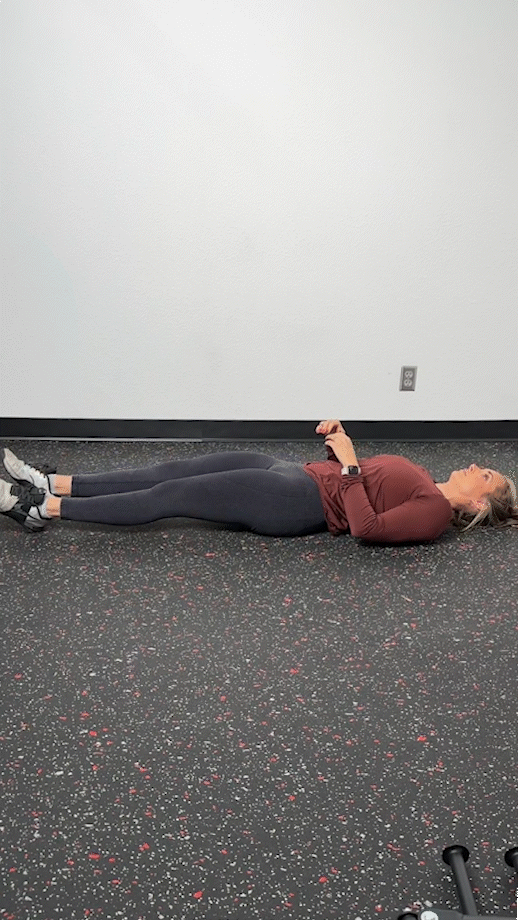
Hamstring Stretch
Muscles worked: Hamstrings, glutes, calves, back, neck
Benefits: Again, your hammies play a major role in knee function since they’re one of the most important muscles for knee flexion. So, the hamstring stretch ranks as one of the best stretching exercises for your knees. According to Heliyon3, “Multiple bouts of [static stretching] can significantly improve hamstring ROM [range of motion],” so you should do this one regularly.
How to do it:
- Sit on the floor with your legs straight out in front of you.
- Tuck your left foot into your right thigh, keeping your right leg straight.
- Lean forward until you feel a stretch in the back of the thigh.
- Hold for 15 to 30 seconds, then release and return to the starting position.
- Repeat the stretch, this time tucking your right foot into your left thigh.
RELATED: Best Hamstring Stretches
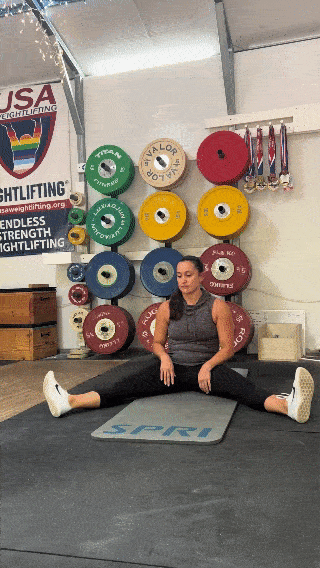
Straight-Leg Raise
Muscles worked: Quadriceps, hip flexors, core
Benefits: The straight-leg raise is a simple exercise that also serves as a test, the aptly named “straight-leg raise test4,” that healthcare professionals use during an initial diagnosis of leg or lower back pain. The straight-leg raise predominantly targets and strengthens the quadriceps, which, according to the Journal of Orthopaedic Surgery5, are so effective that they may help recent recipients of a total-knee arthroplasty recover faster.
How to do it:
- Lie back on the floor with your legs straight out in front of you.
- Lift your right leg in the air, keeping your left leg on the floor (or knee bent).
- Hold for 15 to 30 seconds, then release and return to the starting position.
- Repeat the stretch for your other leg.
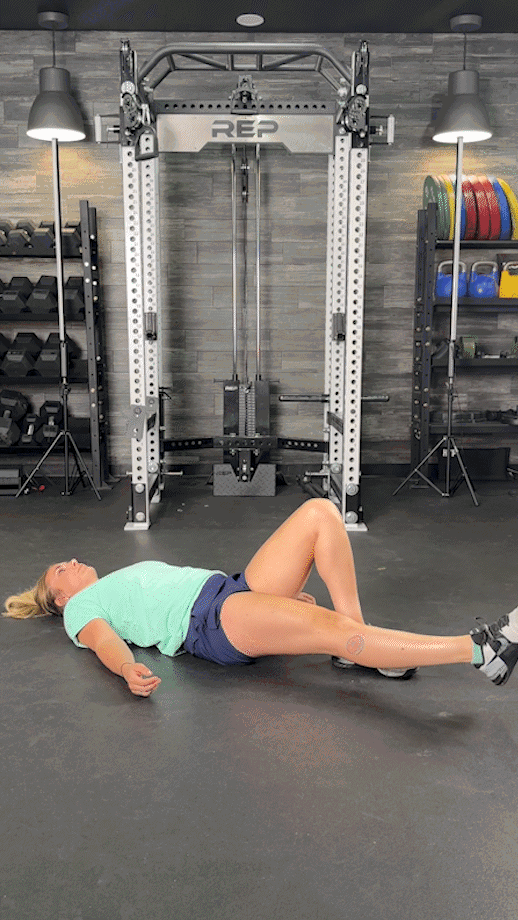
Quad Stretch
Muscles worked: Quadriceps
Benefits: “Your quads are one of the largest muscle groups in your lower body, and they play a critical role in extending and stabilizing your knees,” says Kate Meier, NASM-CPT, USAW-L1, CF-L1, “so, the quadriceps stretch is one of the best stretches for improving knee flexibility and mobility.”
How to do it:
- Stand with a strong upper body posture and your feet shoulder-width apart.
- Lift your left foot behind you and grab the top of it with your left hand.
- Pull your foot toward your glutes until you feel a stretch in the front of the thigh.
- Hold for 15 to 30 seconds, then release with control.
- Repeat the stretch with your right foot.
RELATED: Best Quad Stretches
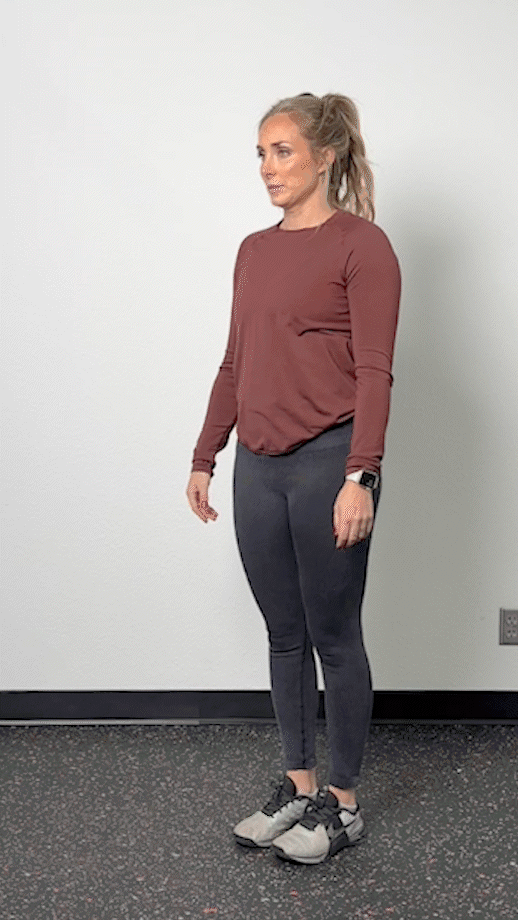
Side-Lying Adduction
Muscles worked: Hip adductors
Benefits: The side-lying adduction exercise strengthens your hips and inner thigh muscles, which, in turn, lightens the load on your quads and knees and thus promotes knee health.
How to do it:
- Lie on your right side with your right hip and right forearm resting on the mat.
- Bend your top leg and place the foot on the floor in front of your bottom leg.
- Put your left hand in front of your body for support.
- Brace your core and lift your right leg to close the gap between your thighs.
- Squeeze your thigh muscles at the top, then slowly return to the starting position.
- Repeat for reps, then switch sides and repeat the set.
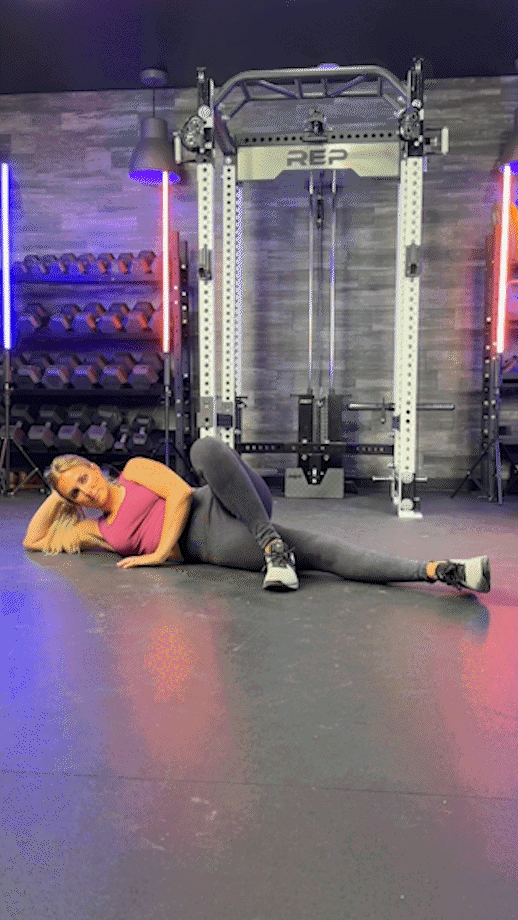
Seated Leg Raise
Muscles worked: Quadriceps, hip flexors, core
Benefits: The seated leg raise is a fantastic strengthening exercise for your quads, hip flexors, and core, which can help alleviate some of the stress you put on your knee joints during daily activities like walking, running, or jumping. Doing these in a chair is especially helpful for individuals with chronic knee joint pain or those recovering after a knee injury or operation.
How to do it:
- Sit in a chair with your knees bent at 90 degrees.
- Place your hands palms-down on your seat.
- Straighten one leg by slowly lifting it toward the ceiling.
- Continue until your leg is nearly parallel with the floor.
- Pause, then slowly return to the starting position.
- Repeat the movement using your other leg or perform the movement with both legs simultaneously.
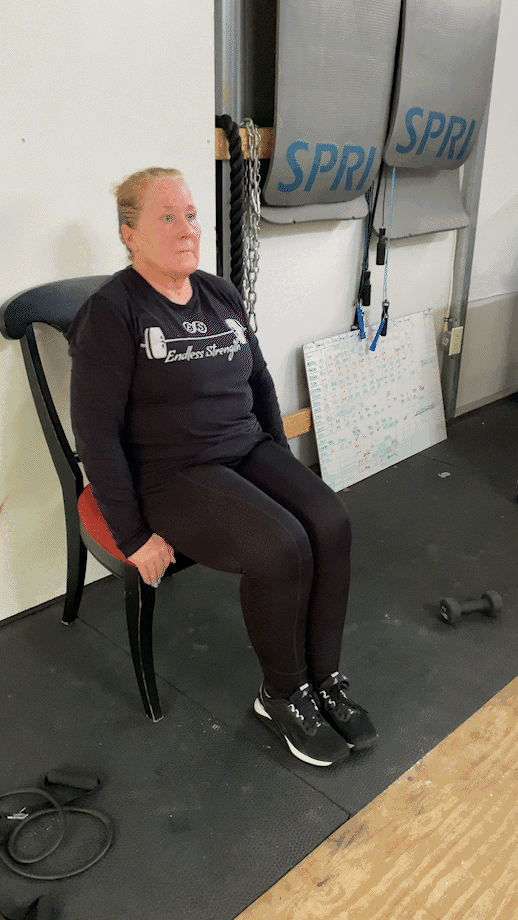
Figure-Four Stretch
Muscles worked: Glutes, hips
Benefits: It’s a bit tricky to get into the position when you’re first learning the figure-four stretch. But when you do, this stretching exercise loosens your glutes, namely the gluteus medius and often-overlooked piriformis muscle, to relieve pressure on your quads and, as a result, your knees.
How to do it:
- Lie supine (face up) with your knees bent and your feet flat on the floor.
- Raise your left leg and place your left ankle just above your right knee.
- Extend both of your arms forward, reaching your left arm through your legs, and grab your leg just below your knee.
- Pull your knee into your chest until you feel the stretch.
- Hold for 15 to 30 seconds, then release.
- Repeat the stretch for your opposite side.
RELATED: Best Glute Stretches
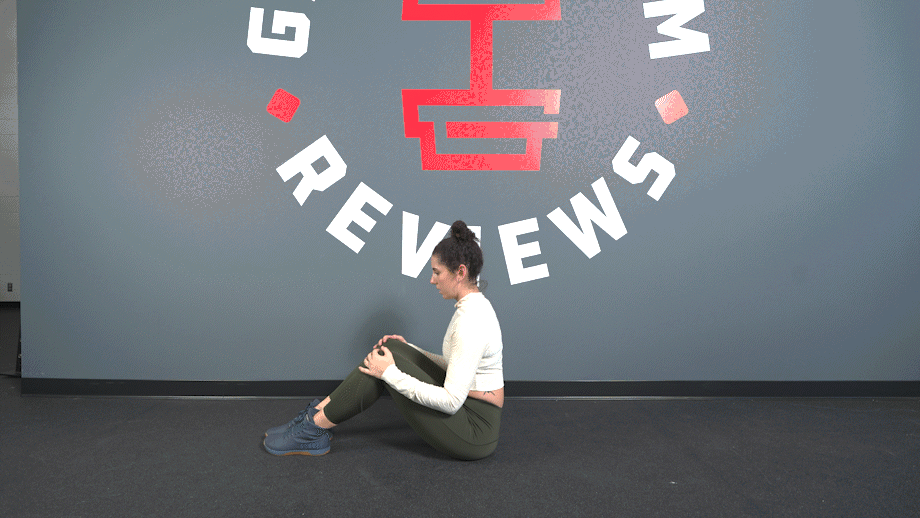
Piriformis Stretch
Muscles worked: Glutes, piriformis
Benefits: Piriformis weakness or tightness puts extra strain on the knees when you walk, so loosening up this often-overlooked gluteal muscle helps reduce that impact and move with less nagging aches and pains.
How to do it:
- Sit in a chair or a bench with your left foot flat on the floor and your right ankle crossed over your left knee, creating a figure-four shape.
- Gently push down on the knee of your top leg until you feel a stretch in your glutes.
- Hold for 15 to 30 seconds, then release.
- Switch legs and repeat the stretch.
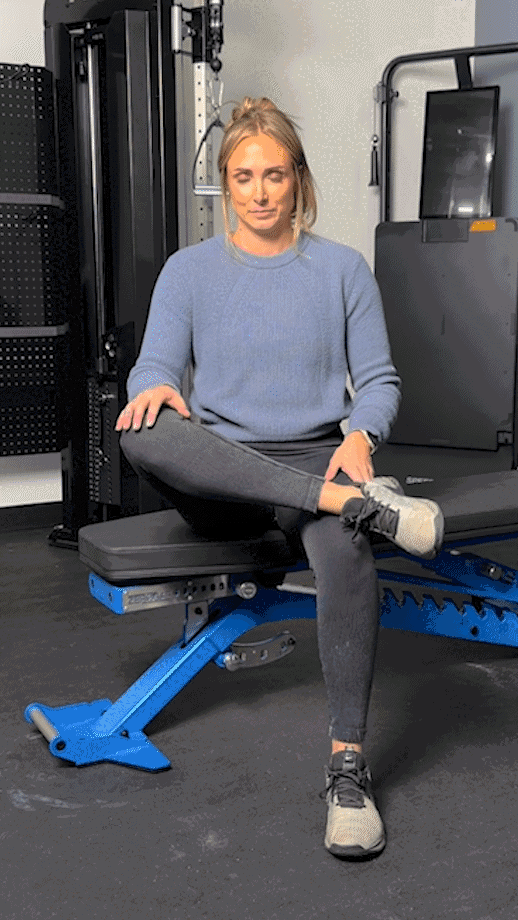
Ankle Mobility Stretch
Muscles worked: Calves
Benefits: “Stretching your ankles improves ankle flexibility and mobility, relieves calf tightness, and improves your overall movement efficiency,” says Kate. “That helps lighten the load on your knees, promoting greater overall knee health and function.”
How to do it:
- Enter a half-kneeling position: right knee bent at a 90-degree angle, left knee and right foot planted flat on the floor.
- Drive your knee forward past your toes and hold for approximately 5 seconds.
- Return to the starting position, then drive your knee outward for 5 seconds.
- Return to the starting position, then drive your knee inward for 5 seconds.
- Switch legs and repeat the stretch for your other side.
RELATED: Best Mobility Exercises
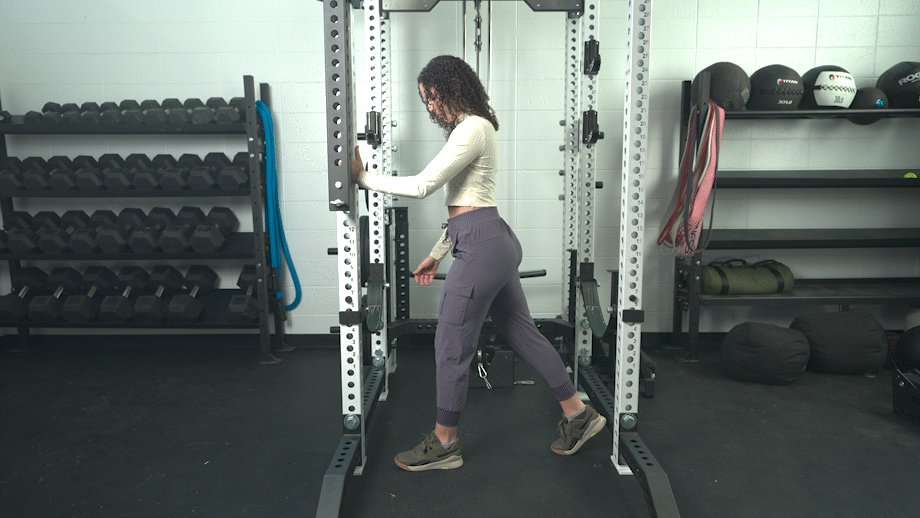
Gastrocnemius Calf Stretch
Muscles worked: Calves
Benefits: A 2020 study in the Journal of Taibah University Medical Sciences6 recommended that patients with knee osteoarthritis incorporate calf strengthening exercises to reduce symptoms of the condition. Stretching your calf muscles isn’t only for individuals with osteoarthritis; everyone can benefit from the added stability provided by loosening up their calves.
How to do it:
- Stand in a staggered stance in front of a wall with your toes pointing forward.
- Place your hands on the wall at approximately shoulder height for support.
- Straighten your back leg, keeping your back heel on the floor at all times.
- Lean forward, bending your front knee as you move, until you feel a light stretch.
- Hold for 15 to 30 seconds, then release.
- Switch legs and repeat.
RELATED: Calf Exercises
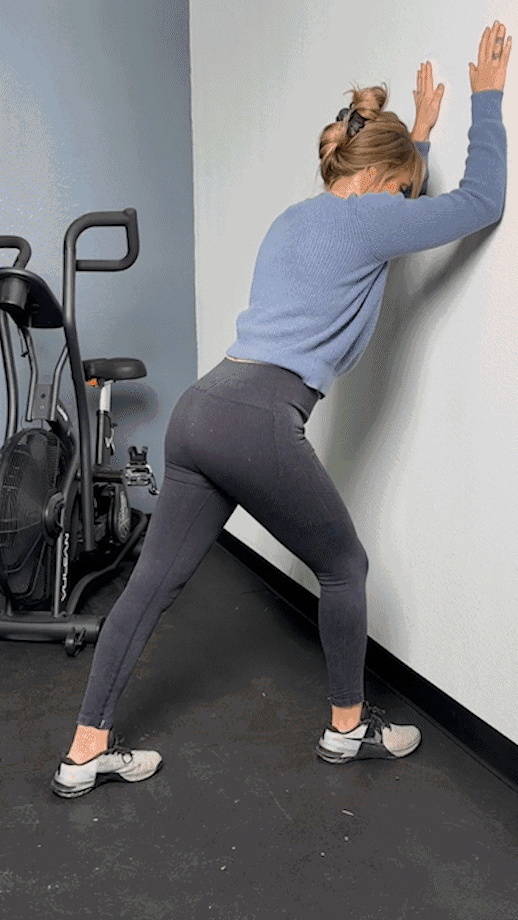
Half-Kneeling Hip Flexor Stretch
Muscles worked: Hip flexors, glutes
Benefits: Opening up your hips with stretching exercises like the half-kneeling hip flexor stretch can help reduce pressure on your quadriceps and knees. That means less soreness and knee joint pain during your daily activities, as well as overall improved movement mechanics, thanks to the reduced lower-body muscle tightness.
How to do it:
- Enter a half-kneeling position: left knee bent at a 90-degree angle, right knee and left foot planted flat on the floor.
- Lean into the front knee, opening your hips so that they’re squared with the front of the room.
- Hold for 15 to 30 seconds, then release.
- Switch legs and repeat.
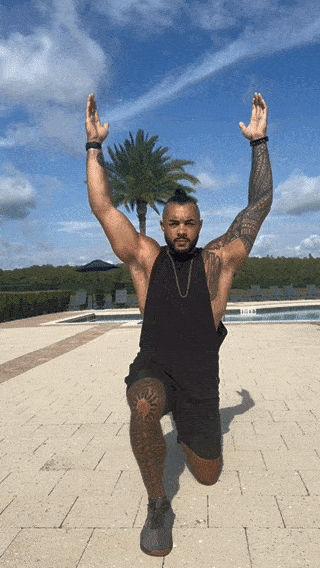
Wall Squat
Muscles worked: Glutes, quadriceps, hamstrings, core
Benefits: According to a study in Medicine and Science in Sports and Exercise7, “The squat can be effective in developing hip, knee, and ankle musculature” because of the muscle activation in your quads, glutes, and hamstrings. Standard bodyweight squats may be difficult for beginners, so the wall squat can be an excellent modification.
How to do it:
- Stand with the back of your head, shoulders, and glutes resting against a wall.
- Step forward so that your feet are roughly one or two feet from the wall.
- Bend your knees and slowly slide your back down the wall.
- Continue until your thighs are nearly parallel to the floor.
- Pause, then drive through your heels to slide back up to the starting position.
- Repeat for reps.
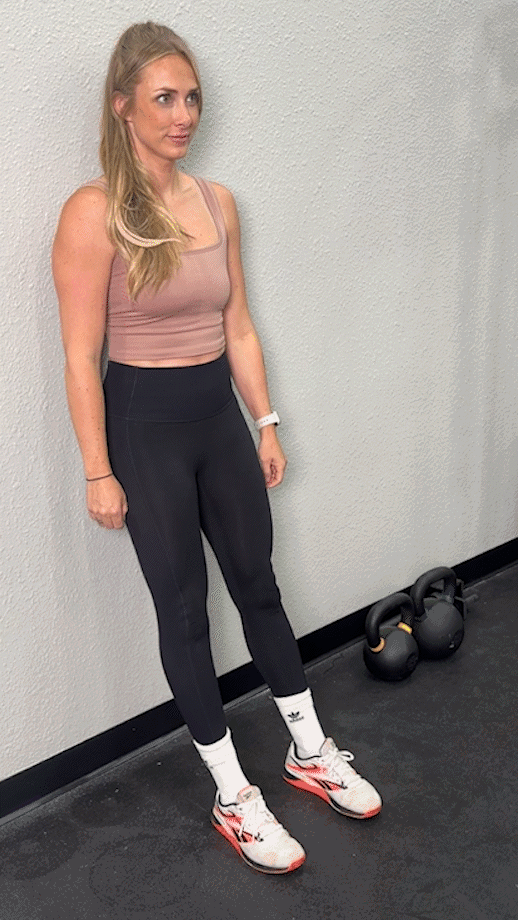
Air Squat
Muscles worked: Glutes, quadriceps, hamstrings, core
Benefits: Some studies8 caution against the squat exercise, especially if you’re working around knee pain, because the peak stress squats may place on your knee joints put you at a higher risk for developing knee injuries and conditions like patellofemoral pain syndrome. Others disagree with this notion; for example, Sports Medicine9 found that “Squats do not contribute increased risk of injury to passive tissues” and “present an effective training exercise for protection against injuries and strengthening of the lower extremity.”
How to do it:
- Stand tall with your feet hip-width apart.
- Position your arms either down by your sides, extended in front of your body, or across your chest. Squeeze your glutes, engage your core, and keep your head neutral.
- Squat toward the floor by bending your knees, ensuring that your knees align with your toes. Then pause momentarily when your quadriceps are at least parallel to the ground.
- Drive your heels into the floor to slowly return to the standing position.
- Continue for the desired number of reps.
RELATED: Proper Squat Form
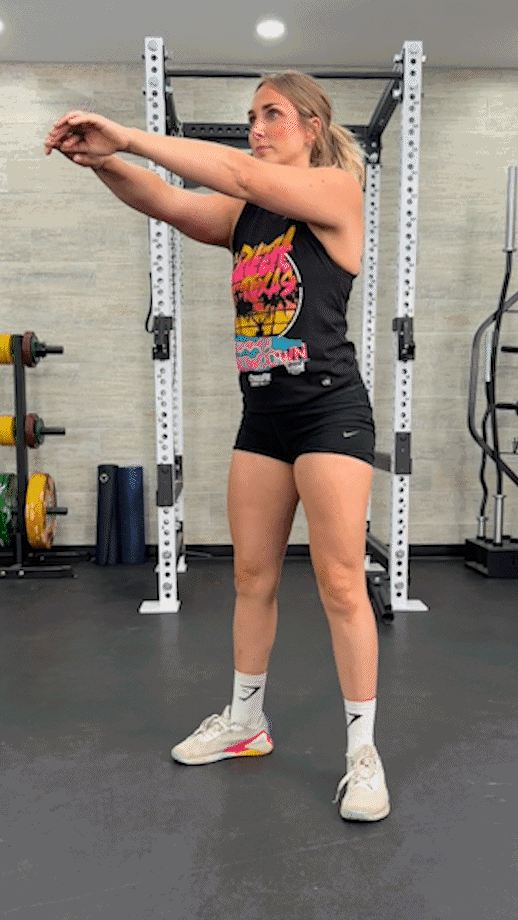
Deep Lunge Stretch
Muscles worked: Hip flexors, hamstrings, quads, glutes, calves, lower back
Benefits: The lunge exercise strengthens various lower body muscle groups, meaning you’ll enjoy improved lower-body strength, mobility, and stability that promotes greater overall knee health. Performing lunges and getting into a nice deep lunge stretch both provide these benefits, so don’t be shy about programming a few sets of lunges and close out your training session with a deep lunge stretch to loosen everything up.
How to do it:
- Stand with your chest tall, back straight, and feet shoulder-width apart.
- Step forward to enter a wide lunge stance, bending both knees as you move.
- Lean forward into your front knee until it’s at a 90-degree angle.
- Hold for 15 to 30 seconds, then release and return to the starting position.
- Switch legs and repeat.
RELATED: Your Guide to Lunges Exercise
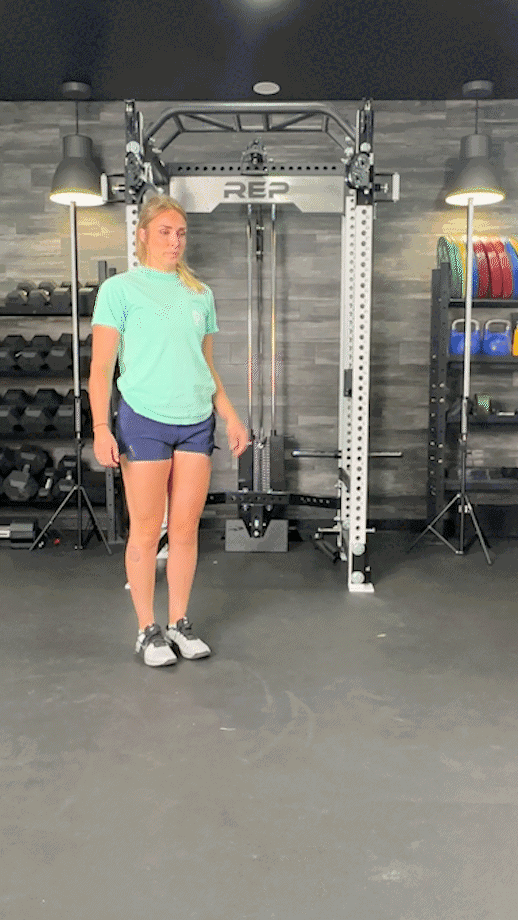
Sample Knee Stretch Workouts
Your joints tend to feel a little worse for wear after a rigorous Leg Day workout, so it’s important to give your joints—not just your knee joints, but your hips and ankles as well—a little attention before you complete your cool-down and get on with your day.
RELATED: Cool-Down Exercises
As with all stretching routines, get in and out of each stretch slowly, really feeling that stretch in the target region before moving on to the next stretch or exercise.
| Exercise / Stretch | Sets | Reps / Duration |
| Wall Squat or Air Squat | 2-3 | 6-12 reps |
| Quad Stretch | 2-3 | 15-30 sec |
| Gastrocnemius Calf Stretch | 2-3 | 15-30 sec |
| Ankle Mobility Stretch | 2-3 | 15-30 sec |
| Deep Lunge or Half-Kneeling Hip Flexor Stretch | 2-3 | 15-30 sec |
| Figure-Four or Piriformis Stretch | 2-3 | 15-30 sec |
| Straight or Seated Leg Raise | 2-3 | 6-12 reps |
| Knee-to-Chest Stretch | 2-3 | 15-30 sec |
| Hamstring Stretch | 2-3 | 15-30 sec |
| Side-Lying Adduction | 2-3 | 15-30 sec |
Equipment needed: Exercise mat
What Muscles Make Up Your Knee?
The knee joint10 is the largest joint in the human body, which is part of what makes suffering a knee injury so disastrous. Incorporating the best knee stretches and exercises into your training may reduce your risk of injury, provided you’re targeting and strengthening the supporting muscles surrounding this crucial joint.
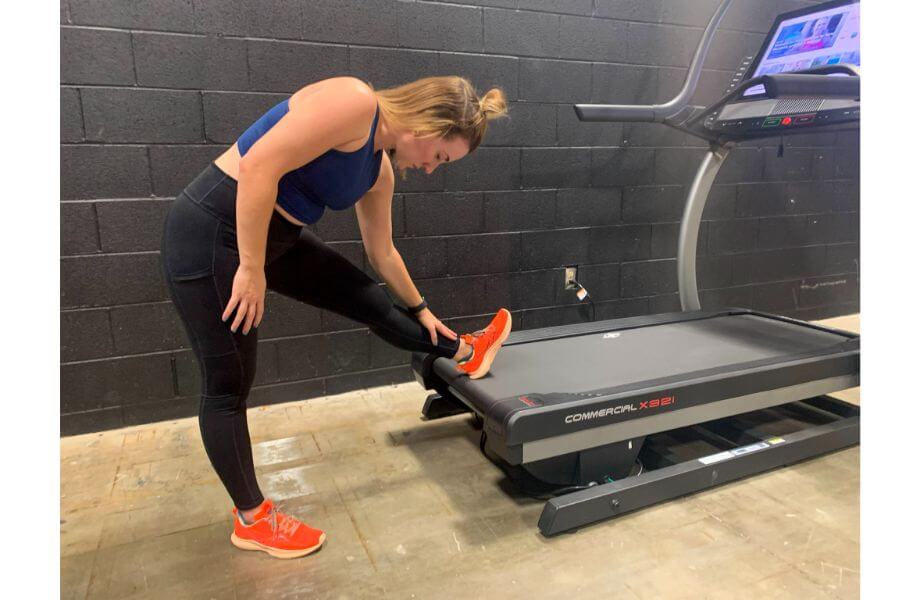
The most important muscle groups that surround your knee include:
- Quadriceps: One of the largest muscle groups in your legs, the quads are the primary knee extensors, so you’ll need them every time you rise from the bottom of a squat or stand up out of a chair. They also work to stabilize and protect the knee joint.
- Hamstrings: Your hamstrings form an antagonistic pair with the quadriceps because, as your body’s primary knee flexors, they relax when the quads contract and vice versa.
- Calves: Your calf muscle includes the important gastrocnemius muscle, which crosses the knee and contributes to knee stability. The calves are also crucial for proper gait and walking mechanics, which reduces the impact on your knees and protects them.
- Hips: Reducing tightness in your hip flexors and adductors promotes greater lower-body mobility and flexibility, which, in turn, promotes better biomechanics and reduces the strain on your precious knee joints.
Benefits of Knee Stretches
Stretching is commonly worked into our warm-ups and cool-downs, but what’s so important about knee stretches? Why should we add the above knee stretches and exercises into our workout routines?
Improved Performance
Strength training does a lot for building strength and muscle, but it’s only a cog in a much larger machine, and to get your best results, you want to do as many “right” things as possible.
According to a 2021 study in the Journal of Strength and Conditioning Research11, subjects who completed a six-week static stretching program focused on the knee extensors showed an improved range of motion and greater power production from the knees.
In addition, a 2023 review in Sports Medicine12 determined that static stretching programs had “the potential to improve muscle strength and power.”
Improvements in strength, power, and flexibility benefit athletes looking to perform at the highest level, and they help make completing daily activities easier for everyday people.
Reduced Knee Pain
A 2022 review in Physiotherapy13 found that stretching exercises may be useful for reducing pain in patients with knee osteoarthritis.
A 2023 review in Sports Health14 echoed these findings, concluding that “Stretching is an effective strategy for improving knee total, flexion and extension ROM, and pain” and that stretching may be “an appropriate conservative intervention to improve patient outcomes.”
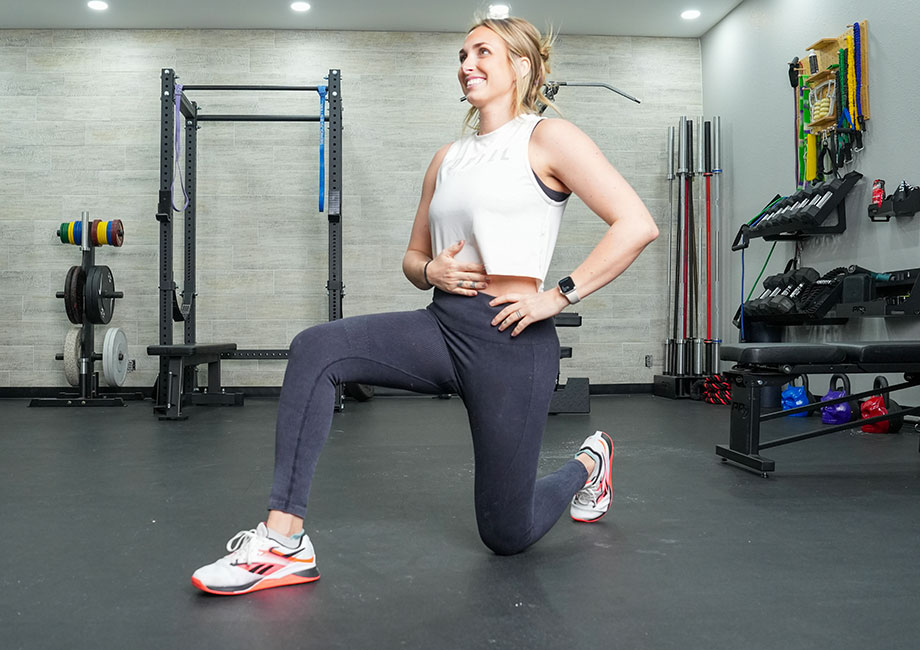
Although numerous studies have observed positive outcomes for participants with knee pain and osteoarthritis, you should seek medical advice from your doctor and/or consider working with a physical therapist or DPT before adopting a new workout or stretching routine.
Only a doctor or other qualified healthcare professional can provide an actual diagnosis and personalized care plan for you and your condition.
May Reduce Your Risk of Injury
Knee injuries are prevalent, whether caused by wear and tear, overuse, or exercising with poor form, among some of the most common causes. You’ll want to do everything you can to reduce the likelihood of suffering a knee injury.
Performing knee stretches and exercises regularly helps loosen the surrounding muscle groups, alleviate muscle tightness, and strengthen the stabilizing muscles,” says Kate, “effectively reducing your risk of suffering a knee injury.”
Knee Stretches: Final Thoughts
We don’t all have the same health and fitness goals, but I’d presume that we all want to live a generally pain-free life and be able to do the things we want to do without having to work around pain or discomfort.
Unfortunately, knee pain is a globally prevalent condition that can tremendously complicate your daily life, making working knee stretches into your workout routine critical.
Knee stretches:
- Improve lower body and knee function
- Protect the knee joint by reducing injury risk
- Increase knee flexibility, mobility, and stability
- May help enhance athletic performance
- May help alleviate pain from knee osteoarthritis and other conditions
Isn’t it time you give a little TLC to those poor knees of yours? Add our list of knee stretches into your next Leg Day workout and see what they can do for you!
Knee Stretches: FAQs
How do you get rid of knee pain ASAP?
The best way to get rid of knee pain depends entirely on why you’re having knee pain in the first place. Stretching and foam rolling may alleviate some of the pain, while the RICE method—rest, ice, compression, elevation—may provide some positive results, too.
If you’re unsure why you’re experiencing knee pain, it’s best to visit your doctor or another qualified healthcare professional and get a medical diagnosis.
RELATED: 10 Tips to Speed Up Muscle Strain Recovery From a Physical Therapist
Should I stretch my knee if it hurts?
It depends on the severity of the pain, but provided you haven’t severely injured yourself, stretching may help alleviate some of that pain. If you’re unsure why you’re in pain, don’t try to power through; get medical advice ASAP!
What is the #1 mistake that makes bad knees worse?
Sedentary lifestyles, overuse, and exercising with improper form may all negatively impact your knee function and health. Adding knee stretches into your routine may help combat those effects.
References
- Duong V, Oo WM, Ding C, Culvenor AG, Hunter DJ. Evaluation and Treatment of Knee Pain: A Review. JAMA. 2023;330(16):1568-1580. doi:10.1001/jama.2023.19675
- Dydyk AM, Sapra A. Williams Back Exercises. [Updated 2023 May 1]. In: StatPearls [Internet]. Treasure Island (FL): StatPearls Publishing; 2024 Jan
- Cai P, Liu L, Li H. Dynamic and static stretching on hamstring flexibility and stiffness: A systematic review and meta-analysis. Heliyon. 2023;9(8):e18795. Published 2023 Jul 29. doi:10.1016/j.heliyon.2023.e18795
- Camino Willhuber GO, Piuzzi NS. Straight Leg Raise Test. [Updated 2023 Jun 12]. In: StatPearls [Internet]. Treasure Island (FL): StatPearls Publishing; 2024 Jan
- Suh J, Liow MHL, Pua YH, et al. Early postoperative straight leg raise is associated with shorter length of stay after unilateral total knee arthroplasty. J Orthop Surg (Hong Kong). 2021;29(1):23094990211002294. doi:10.1177/23094990211002294
- Alshami AM, Alhassany HA. Girth, strength, and flexibility of the calf muscle in patients with knee osteoarthritis: A case-control study. J Taibah Univ Med Sci. 2020;15(3):197-202. Published 2020 May 1. doi:10.1016/j.jtumed.2020.04.002
- Escamilla RF. Knee biomechanics of the dynamic squat exercise. Med Sci Sports Exerc. 2001;33(1):127-141. doi:10.1097/00005768-200101000-00020
- Pereira PM, Baptista JS, Conceição F, Duarte J, Ferraz J, Costa JT. Patellofemoral Pain Syndrome Risk Associated with Squats: A Systematic Review. Int J Environ Res Public Health. 2022;19(15):9241. Published 2022 Jul 28. doi:10.3390/ijerph19159241
- Hartmann H, Wirth K, Klusemann M. Analysis of the load on the knee joint and vertebral column with changes in squatting depth and weight load. Sports Med. 2013;43(10):993-1008. doi:10.1007/s40279-013-0073-6
- Gupton M, Imonugo O, Black AC, et al. Anatomy, Bony Pelvis and Lower Limb, Knee. [Updated 2023 Nov 5]. In: StatPearls [Internet]. Treasure Island (FL): StatPearls Publishing; 2024 Jan
- Ikeda N, Ryushi T. Effects of 6-Week Static Stretching of Knee Extensors on Flexibility, Muscle Strength, Jump Performance, and Muscle Endurance. J Strength Cond Res. 2021;35(3):715-723. doi:10.1519/JSC.0000000000002819
- Arntz F, Markov A, Behm DG, et al. Chronic Effects of Static Stretching Exercises on Muscle Strength and Power in Healthy Individuals Across the Lifespan: A Systematic Review with Multi-level Meta-analysis. Sports Med. 2023;53(3):723-745. doi:10.1007/s40279-022-01806-9
- Luan L, El-Ansary D, Adams R, Wu S, Han J. Knee osteoarthritis pain and stretching exercises: a systematic review and meta-analysis. Physiotherapy. 2022;114:16-29. doi:10.1016/j.physio.2021.10.001
- Campbell TM, Westby M, Ghogomu ET, Fournier J, Ghaedi BB, Welch V. Stretching, Bracing, and Devices for the Treatment of Osteoarthritis-Associated Joint Contractures in Nonoperated Joints: A Systematic Review and Meta-Analysis. Sports Health. 2023;15(6):867-877. doi:10.1177/19417381221147281
Further reading

Looking for a snack that won't derail your fitness goals? Check out our list of the best protein bars for weight loss. Read more

In our MAPS Anabolic review, we’ll cover the pros and cons of this online workout program, and how well the muscle-building routine works.. Read more

Our Arch Nemesis Swiss Bar review takes a close look at this specialty barbell and compares it to other options on the market today. Read more

The American Flag is a common site in garage gyms in the US. Unfortunately, it's often hung incorrectly which is against the guidelines that our forefathers set and soldiers have fought for. Here's how and why you should hang the US Flag properly. Read more

